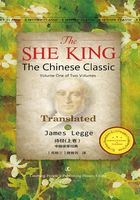
YAY YEW SZE KEUN
1 In the wild there is a dead antelope,
And it is wrapped up with the white grass.
There is a young lady with thoughts natural to the spring,
And a fine gentleman would lead her astray
2 In the forest there are the scrubby oaks;
In the wild there is a dead deer,
And it is bound round with the white grass.
There is a young lady like a gem.
3 [She says], Slowly; gently, gently;
Do not move my handerchief;
Do not make my dog bark.


Ode 12. A VIRTUOUS YOUNG LADY RESISTS THE ATTEMPTS OF A SEDUCER. The little Preface says that the piece teaches disgust at the want of proper ceremonies, and belongs to the close of Chow's reign, when the influence of king ăn was gradually prevailing to overcome the lust and license, through which the Shang dynasty was extinguished. A lady is sought to be won by insufficient ceremonies, yet they were better than none, and showed that the times were mending; and she is willing. He must be clear-sighted who can see traces of all this in the ode. The view which I take of it is substantially the same as Choo's,who inclines to look on it as an allusive piece, but at the same time allows it may be taken as narrative. It is not worth while to enter on this question.
St. 1. L1 1,2. 野 denotes 'the open country, beyond the suburbs', not yet brought under cultivation. 麕,written also with 君 and with 禾 under the 鹿, is said to be the same as the chang (鹿 with 章 under it), which Medhurst calls a kind of musk deer, and Williams, a kind of gazelle. Choo says it is hornless, and Williams thinks therefore it may be the antilope gutturosa, the doe of which has no horns. The figure of the creature,however, in Seu Ting's plates, has short horns. It has yet to be identified.茅 is a name both of a grass and a rush; here apparently, designating the former. We are told that 'it is very common, with a large leaf,soft and white, the lines on it quite straight'. L .3. We have already seen that the spring was the favourite time for marriages. The ancient legislators of China would have the pairing time of the lower creatures to be also the nuptial season in human societies; 懷春,'cherishing the spring', therefore=thinking of marriage.L .4. 吉=美 'fine', 'elegant'; but we must understand the epithet to be applied ironically. So, Yen Ts'an. I do not see how 誘 can have any other meaning than that given to it in the translation. Maou's explanation of it by 道, so that 誘之=謂之, in IX. 3, is inadmissible.
St. 2. L1.1,3. All that we learn from Maou and Choo about the p'uh-suh is that it is 'a small tree'. The figure of it in the Japanese plates to the She leaves no doubt that it is a kind of oak. An able botanist in Yokohama to whom it was submitted, pronounced it the quercusserrata. I have ventured, therefore, to translate the name 'by scrubby oaks'.

